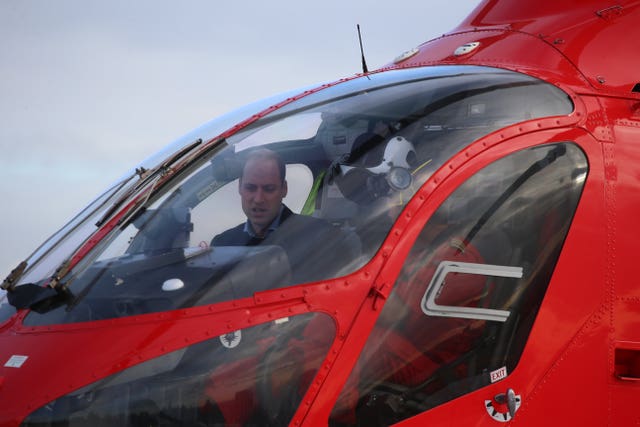
The Duke of Cambridge flew a helicopter to a London hospital as he celebrated the 30th anniversary of the capital’s air ambulance service.
William, a former pilot with the East Anglian Air Ambulance (EAAA), boarded the aircraft at his home, Kensington Palace, and took the controls for the 25-minute trip.
The duke’s flight in London’s Air Ambulance Charity’s helicopter came as he was named the patron of the service’s 30th Anniversary Campaign, which aims to raise awareness about its work and support for the development of new facilities.
During the visit William was shown a graphic demonstration of paramedics dealing with a stab victim, but in a lighter moment when given a card to mark wife Kate’s 37th birthday, confessed: “I did remember this morning – so I was OK.”
The duke later said he had not flown since June but the charity’s chief pilot, Neil Jeffers, said he was impressed with the royal’s skills as an aviator.

He said: “We landed at Kensington Palace, we put him in the right seat, the captain’s seat of the aircraft, he has only flown the aircraft a couple of times but was happy to fly it.
“So he did all the flying from the palace, we had a look around London looking at some landing sites.”
William landed at the charity’s helipad on the Royal London Hospital in Whitechapel, east London – a spot he has flown to a number of times as an air ambulance pilot.
The duke joined the EAAA as a pilot in March 2015 and, after completing an initial period of job-specific training involving simulator, aircraft and in-flight skills training, began piloting his first operational missions in July 2015 before his last in July 2017.
Throughout his service William was based at Cambridge Airport as part of a team including specialist doctors, critical care paramedics and pilots providing emergency medical services across Bedfordshire, Cambridgeshire, Norfolk and Suffolk.
After he stepped from the charity’s MD 902 Explorer helicopter, one of two used by the organisation but not in service, he told its chief executive Jonathan Jenkins: “Flying around here is the best thing ever – amazing”.
The chief pilot said about the duke: “He flies sporadically, he’s a busy man, has a family to look after, he hasn’t flown for quite a few months but when you have that motor programme, like riding a bike, you don’t often forget it.
“He’s very switched on, he’s passionate about it and flies incredibly well for someone who doesn’t fly that often.”
After landing on the helipad, with London’s skyline as a backdrop, William was shown a realistic mock-up of an air ambulance call-out to a person stabbed in the groin, and he watched as an open-air operation to stop the bleeding was performed but failed.
There was a pool of blood on the floor and the air ambulance crew were assisted by London Ambulance Service paramedics and police officers, while a relative of the mock victim was comforted nearby.
The air ambulance attends about five emergencies a day on average and during 2017 its most common call-outs were to stabbings and shootings.
Later William met two families whose loved ones had been helped by the service including Yair Shahar, 49, who received critical treatment when he was run over by a car while cycling in Edmonton, north London, in 2016.
Mr Shahar, from Finchley, whose six-year-old daughter Alma made the birthday card for Kate, told William that his life had changed in a “millisecond”.
He said after the visit: “My pelvis was crushed front and back and I was smashed inside. I could hear the crunch. They said there was some internal bleeding that was critical. I was conscious throughout and was screaming my head off.”
Mr Shahar said it was unclear if he would have survived without the treatment from the air ambulance medical crew but he still remained in touch with the service to this day.
The London’s Air Ambulance Charity was established in 1989 following a growing consensus of opinion that victims of serious accidents were dying because of the delay in expert medical help reaching them, and the time it took to transport patients to hospital.
The service pioneered the doctor-on-board model for air ambulances and aims to bring the hospital emergency department to the scene of an incident.
The charity’s chief executive Jonathan Jenkins said: “So the curious thing about London’s Air Ambulance is that what’s hardwired into us, as much as we’re celebrating the past it’s all about tomorrow, the next patient, the new survivors if you like.”
He said about William: “He absolutely understands what our colleagues go through day to day. He understands the challenges, the opportunities – so for us I don’t think we could have asked for anybody better to be the patron.”


Comments: Our rules
We want our comments to be a lively and valuable part of our community - a place where readers can debate and engage with the most important local issues. The ability to comment on our stories is a privilege, not a right, however, and that privilege may be withdrawn if it is abused or misused.
Please report any comments that break our rules.
Read the rules here